- Subscribe Now

Air Warfare
- Cyber Opens in new window
- C4ISR Opens in new window
- Training & Sim
- Asia Pacific
- Mideast Africa
- The Americas
- Top 100 Companies
- Defense News Weekly
- Money Minute
- Whitepapers & eBooks Opens in new window
- DSDs & SMRs Opens in new window
- Webcasts Opens in new window
- Events Opens in new window
- Newsletters Opens in new window
- Events Calendar
- Early Bird Brief
- Digital Edition Opens in new window
US Air Force blows up a target with a cruise missile from a cargo plane

WASHINGTON — The U.S. Air Force on Thursday destroyed a target in the Gulf of Mexico with a cruise missile launched from the back of a cargo aircraft, marking the first live-fire test of its Rapid Dragon program .
The final flight test of Rapid Dragon, which took place at the overwater test range at Eglin Air Force Base in Florida, marks a step forward in the Air Force Strategic Development Planning and Experimentation office’s “bomb bay in a box” effort to develop a palletized munition system.
The Air Force Research Laboratory said in a Thursday release the program could lead to the U.S. and allies being able to turn cargo aircraft into heavily armed bomb trucks, as well as give combatant commanders more firepower to turn on enemy targets from a safe distance.
Last month, the Air Force carried out a similar test with an unarmed long-range cruise missile separation test vehicle, which had no warhead or engine.
This time, the cruise missile carried by an Air Force Special Operations Command MC-130J Commando II aircraft was armed, AFRL said in the release. The battle management system on the MC-130 received new targeting data in-flight, and then that data was routed to the cruise missile flight test vehicle. This was the first time new targeting data was received and uploaded to a live cruise missile during a flight.
When the MC-130 had reached the drop zone over the Gulf of Mexico, its crew airdropped the palletized munition system containing a single cruise missile, and three weights simulating the mass and shape of cruise missiles.
A parachute deployed to stabilize the falling Rapid Dragon system, and the missile and three dummy weights began to release sequentially to avoid collisions. The way in which the cruise missile separated from the deployment box this time was “unconventional,” AFRL said — it deployed vertically, with its nose down.
The cruise missile immediately sprung its wings and tail, got aerodynamic control of itself, fired up its engine and pulled up under the engine’s power. It then headed toward its target, which it destroyed upon impact, AFRL said.
Now that AFRL proved it can deploy a cruise missile in this way, it hopes to show the palletized weapon system can work with other aircraft. The next Rapid Dragon experiment is scheduled for spring 2022 in a live-fire test with a cruise missile from a C-17 Globemaster.
AFRL said the retargeting methods developed for Rapid Dragon are meant to be adaptable to other strike and mobility platforms. Airmen would be able to roll Rapid Dragon on or off a mobility aircraft without modifying the plane, AFRL said last month.
The Air Force hopes to further broaden Rapid Dragon’s capabilities so the carriage can house additional weapons systems and multiple types of weapons. Two years from now, the Air Force wants to bring this program from a developmental prototype to an operational prototype.
AFRL pointed to the quick development of Rapid Dragon as an example of how government and industry can quickly produce results when collaborating. This live-fire test came five months after the Rapid Dragon team conducted a system-level flight test, which itself came 10 months after the Air Force and its industry partners designed it.
Rapid Dragon has held five flight tests on three different aircraft — the MC-130J, the EC-130SJ and the C-17A — over the last five months.
“This type of experimentation campaign, that address[es] capability gaps and demonstrates transformative efforts, helps us shape future requirements and reduces timeline to fielding,” AFRL Commander Maj. Gen. Heather Pringle said in the release. “This approach ultimately enables a rapid fielding alternative to traditional lengthy acquisition timelines.”
Other contributors to the recent test include the Naval Surface Warfare Center Dahlgren, the Standoff Munitions Application Center, Lockheed Martin Missiles and Fire Control, Systima Technologies, R4 Integration, and the Safran Electronics and Defense subsidiary Parachutes USA.
Stephen Losey is the air warfare reporter for Defense News. He previously covered leadership and personnel issues at Air Force Times, and the Pentagon, special operations and air warfare at Military.com. He has traveled to the Middle East to cover U.S. Air Force operations.
More In Air Warfare

Space Development Agency builds vendor pool for future demo missions
Through the effort, dubbed halo, the agency will run rapid on-orbit demonstrations aimed at reducing risk for future operational missions..

Space Force orders more missile-tracking satellites from Millennium
Millennium will deliver six more spacecraft for the service's missile track custody program as part of the $386 million deal..

Pentagon OKs first batch of private capital funds for loan program
The effort aims to drive private capital funding to companies advancing key dod technologies like artificial intelligence and microelectronics..

Space Force needs plan, funding to counter China’s rapid space growth
For the space force, countering china’s advancements in space is a mission in and of itself, according to the service's top intelligence official..

How an experiment in New Jersey could shape the Army’s future network
Through a series of experiments known as netmodx, the army sought to wring out integrated network capabilities in real-world conditions., featured video, raytheon shows how their systems and solutions provide layered, integrated air and missile defense.

Secretary of the Army speaks on adjusting to global turmoil | Defense News Weekly Full Episode 10.19

How can I protect myself from SMISHING attempts? — Money Minute

How do global events shape the Army? Secretary of the force explains
Trending now, donated aussie abrams tanks to receive baptism of fire in ukraine, us confirms 3,000 north korean troops are training in russia, australia announces $4.7 billion purchase of us air defense missiles, attack on turkish defense firm clears the halls of local arms fair, strike, fixed-price contracts leave boeing defense bleeding cash.

USAF Demonstrates Cruise Missile Launch From Cargo Aircraft

The US Air Force demonstrated a cruise missile launch from a cargo plane using a palletized weapon system for the first time.
The test is part of the Air Force Rapid Dragon Experimentation Program to achieve cost-effective mass delivery of long-range standoff weapons from non-traditional air platforms such as cargo planes.
The launch involved the MC-130J aircraft crew receiving targeting data through a beyond-line-of-sight command and control node for the onboard Battle Management System (BMS).
The BMS then communicated the data to the palletized missile, which was without an engine or warhead. The aircraft then airdropped a four-cell Rapid Dragon deployment system containing the missile and three mass simulants, “which sequentially released from the palletized system.”
Once dropped, the missile activated “its wings and tail, achieved aerodynamic control, and began a pull-up maneuver as it glided toward its new target.”

‘Expands Warfighting Flexibility’
This is the first time a missile — albeit without an engine and warhead — has been used in the test. On all previous occasions, a missile simulator was employed.
Rapid Dragon program manager Dr. Dean Evans said, “In future conflict scenarios against strategic competitors, the ability to cost-effectively deliver long-range standoff weapons en masse from non-traditional platforms expands warfighting flexibility and introduces new deterrence options.”
Future Plans
During the series of tests, the air force demonstrated a high-altitude weapon airdrop, successful jettisoning weapons through a deployment system, and “weapon de-confliction through the clean separation of the weapon and multiple simulants.”
Moving forward, a live, long-range cruise missile “under powered flight” onboard an MC-130J aircraft will be launched to determine potential design refinement, maturation, and eventual deployment. The air force plans to include other weapon systems for similar testing.
Subscribe to our mailing list
Related articles.

Silent Arrow to Begin CLS-300 Drone Test for US Air Force
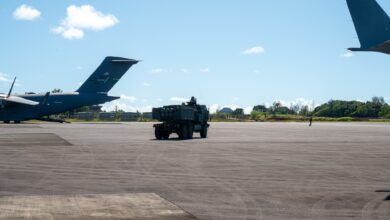
US Military Demonstrates Airfield Seizure Capability Using HIMARS
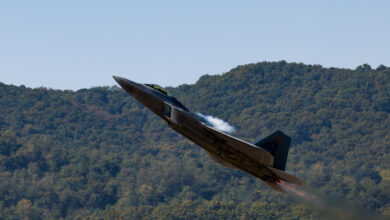
China Says Developing Low-Cost Radar That Can Track F-22 Stealth Fighters
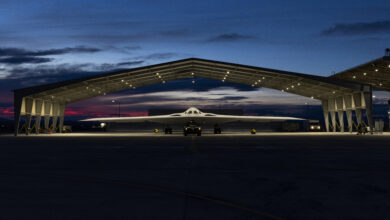
Conti Federal to Construct B-21 Fuel Cell Hangar at Ellsworth AFB
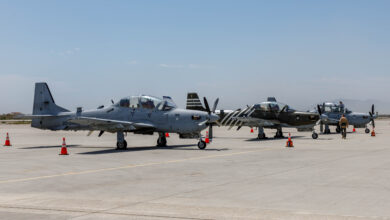
US Air Force Receives Three Super Tucanos for Training, Test Applications

US Air Force Reveals Seven Potential Bases for KC-46A Pegasus

Boeing to Produce Small Diameter Bombs for US, Allies
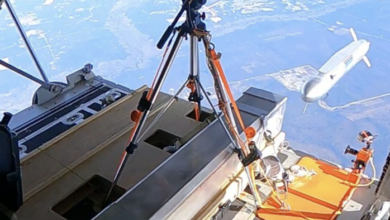
Leidos Unveils ‘Black Arrow’ Small Cruise Missile

RTX’s Pratt & Whitney Opens Largest Military Engine Sustainment Facility
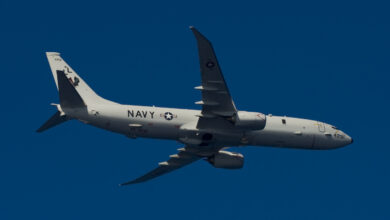

US Navy Chooses L3Harris for P-8A Fleet MRO
- Air Warfare
- Land Warfare
- Naval Warfare
- Networks / Cyber
- Multi-Domain
- CCA Video Series
- 2025 Defense Budget
- Indo-Pacific
- Newsletters
- Newsletter Signup
- Resource Library
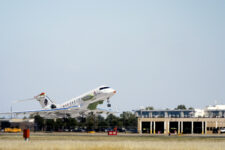
Industry partners announce PEGASUS first flight, tout additional buy

US Army takes on most effective counter-drone system yet: Red tape

Department of the Air Force appoints Susan Davenport as new chief data and AI officer
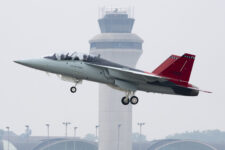
Boeing CEO says defense is ‘core’ to business, doesn’t preclude sell-off of ‘fringe’ assets
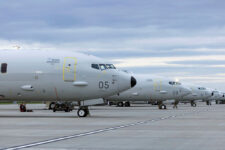
Germany, UK strike ‘first-of-its-kind’ defense deal prioritizing deep strike weapons and drones
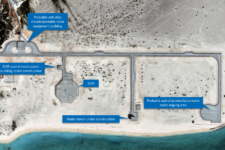
China tightens ‘counter-stealth’ military radar net around South China Sea, says report
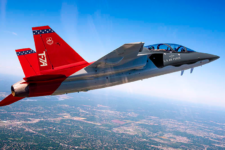
Saab braces for ‘couple of years’ of ‘stop-and-go’ production instability on T-7A trainer fuselage
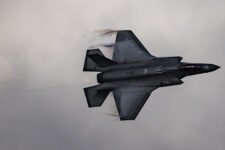
Prolonged F-35 negotiations take a bite out of Lockheed Martin’s third quarter results

Army ISR Task Force to get more permanent home, likely new name, under military intel shop
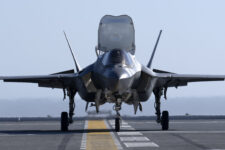
American F-35B lands on a Japanese destroyer for first time: US Navy
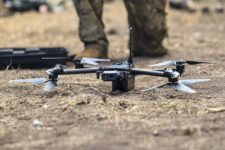
Ground robots challenged, battery issues: Transformation in contact hits the Pacific

Turkish defense spending to reach record high amid neighboring conflicts

In Ukraine, Austin takes aim at Putin ‘apologists,’ decries ‘both sides’ narrative on blame for war
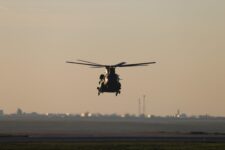
Army picking 2 cargo drones to pair with autonomous boats for Project Convergence 2025
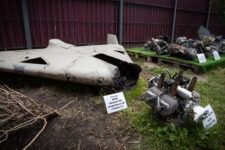
The Army’s ‘most challenging’ unmanned threat? Group 3 drones
Defense industry news, analysis and commentary.
- Special Features
Breaking Defense In your inbox
Want the latest defense industry news? Sign up for the Breaking Defense newsletter.
US Air Force one step closer to turning cargo planes into makeshift bombers
Next month, the air force will see if it can launch a live cruise missile from a pallet that was air dropped by a cargo plane..

During a Nov. 3, 2021 test of the Air Force’s Rapid Dragon concept, an unarmed cruise missile deployed from a pallet airdropped by an MC-130J. (US Air Force)
WASHINGTON: Next month the Air Force will conduct a capstone exercise for a program aiming to turn cargo planes into aerial bomb trucks, when a standard-looking palle t will be airdropped out of an MC-130J and launch a live cruise missile as it parachutes down through the air.
The demonstration will wrap up the first phase of the Air Force’s Rapid Dragon program, the service’s effort validating its “palletized munitions” concept , Dean Evans, the service’s Rapid Dragon program manager, told Breaking Defense today.
In the early stages of a war with a sophisticated adversary like China, the Air Force believes the number of airstrikes being traded will make it difficult for airlift platforms to move people and equipment into threat zones. Further, the service has hypothesized that it may need even more strike capacity than it currently has with its fleet of fighters and bombers.
“The ability to cost-effectively deliver long-range standoff weapons en masse from non-traditional platforms expands warfighting flexibility and introduces new deterrence options,” Evans said.
Or as Lt. Gen Clint Hinote, the Air Force’s futurist, put it last year: “What we see is that no matter how big our bomber force is, the capacity that the joint force needs is always more and more.”
That’s where palletized munitions for airlift assets like cargo planes come in. The thinking is that the service can create a “smart pallet” that looks like the standard pallets used to roll equipment on and off aircraft like the C-130 or C-17, but can feed targeting and launch command information to the guided munitions contained inside of it.
After that pallet is airdropped from a cargo plane and begins its fall to the ground, the pallet would then launch multiple munitions, each intended for different targets and timed to safely separate from each other.
Most recently, the program conducted a successful flight demonstration Nov. 3 at White Sands Missile Range, N.M., where an MC-130J airdropped a pallet containing a long range cruise missile separation test vehicle — basically a cruise missile without an engine or warhead.

U.S. Air Force personnel load a Rapid Dragon deployment system onto an MC-130J aircraft ahead of an airdrop. (US Air Force)
According to an Air Force Research Laboratory news release, the MC-130J crew received targeting data from a beyond-line-of-sight node and then transferred that information from the aircraft’s onboard Battle Management System to the cruise missile test vehicle. The event was the first time that upload of data occurred with an unarmed cruise missile instead of an emulator, AFRL said.
Then, the MC-130J dropped a four-cell Rapid Dragon palletized system from its cargo bay. As the pallet was parachuting down, it sequentially launched the cruise missile test vehicle and three “mass simulants,” which replicate the weight and shape of a cruise missile. The cruise missile test vehicle deployed its wings and tail seconds after release, began pulling up and then glided toward its target.

An airdropped Palletized Munition Deployment System carrying an unarmed cruise missile test vehicle, shown here immediately after being airdropped from an MC-130J during a Nov. 3, 2021 test. (US Air Force)
A demonstration planned for December will use a live cruise missile instead of an unarmed test vehicle and will conclude the first, developmental stage of the program, Evans said.
“The plan is to mature the capability from a developmental prototype to an operational prototype in the next phase,” which will begin next month immediately following a successful demonstration, Evans said. “We will be integrating additional weapons/effects in the next phase of Rapid Dragon” and will test the pallet deployment system’s ability to safely launch multiple weapons, he said.
The Nov. 3 demonstration was performed by an operational Air Force Special Operations Command aircrew, AFRL stated. Other participants included Naval Surface Warfare Center-Dahlgren; Standoff Munitions Application Center; Lockheed Martin Missiles and Fire Control; Systima Technologies; and Safran Electronics & Defense, Parachutes USA.
Last year, Lockheed Martin received a $25 million contract for further work on the Rapid Dragon program. At the time, Scott Calloway, Lockheed’s program director, told reporters its roll on/roll off smart pallet could be configured to carry up to 32 AGM-158B JASSM-ER (Joint-Air-to-Surface Standoff Missile-Extended Range) missiles on a C-17.
Latest from Breaking Defense

Aussie, US test wide range of naval drone tech, C2 during AUKUS-centric exercise

Pentagon info officer’s top priority: Upgrading cryptography ahead of quantum-enabled hackers
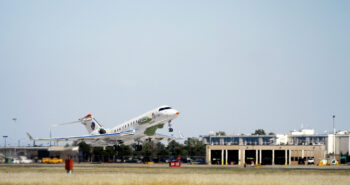
Fighting underground: The US military must learn from Israel’s experience
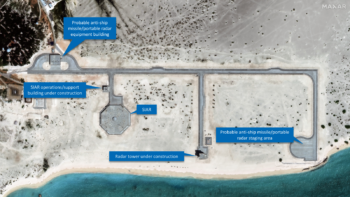
Sign up and get Breaking Defense news in your inbox.
- Advertising & Marketing Solutions
- Breaking Defense
- Breaking Energy
- Breaking Gov
- Above the Law
- Dealbreaker
- MedCity News
Copyright © 2024 Breaking Media, Inc. All rights reserved. Registration or use of this site constitutes acceptance of our Terms of Service and Privacy Policy .
Privacy Center | Do not sell my information
Friend's Email Address
Your Email Address
- svg]:fill-accent-900 [&>svg]:stroke-accent-900">
Air Force shows off its Rapid Dragon cruise missile system on China’s doorstep
By Max Hauptman
Posted on Jul 26, 2023 1:29 PM EDT
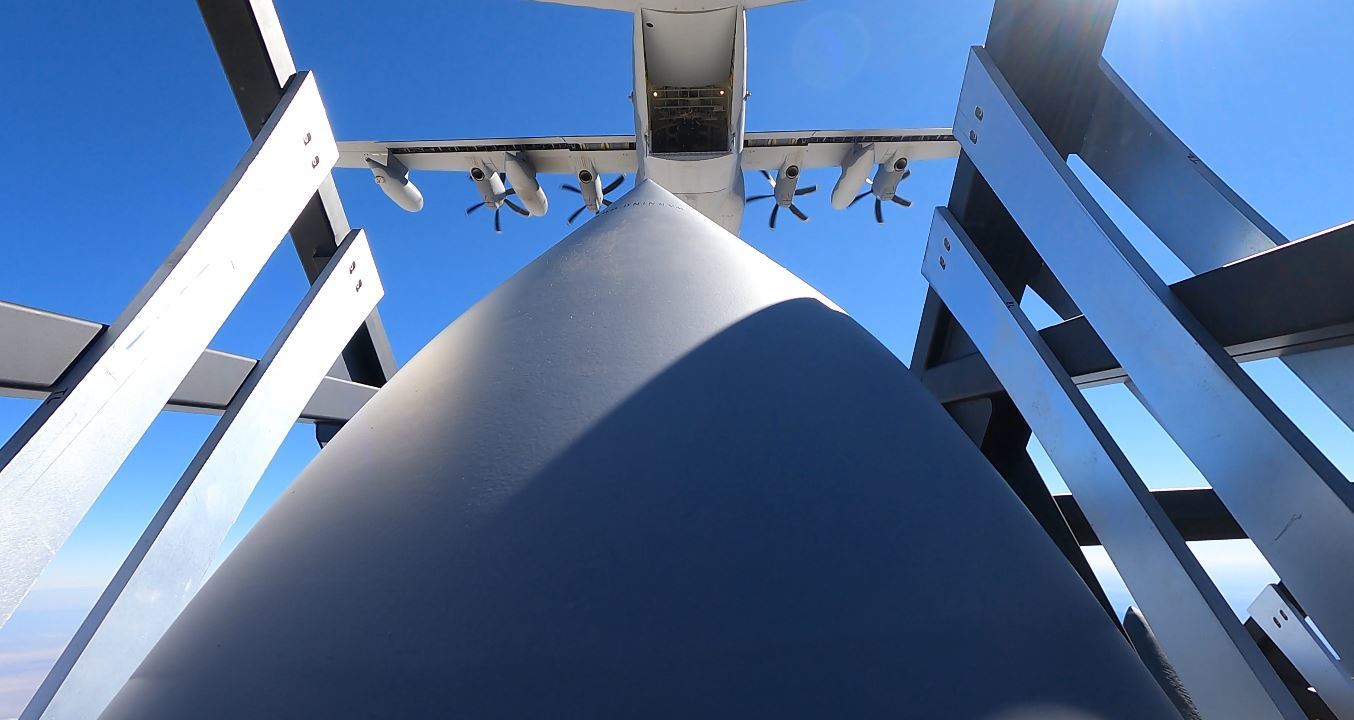
During a multi-nation training exercise in the Pacific this month, the Air Force tested out one of its newest and most unique weapons — a demonstration that Chinese officials likey were paying close attention to.
US forces in the Pacific wrapped up Mobility Guardian 2023 on July 21, a sprawling exercise testing the range and capabilities of some of the Air Force’s largest cargo planes. Sometime during the week, a freighter conducted a test of the Air Force’s Rapid Dragon , a unique system that launches long-range cruise missiles from cargo planes by first dropping them by parachute from the rear of a cargo plane.
Normally, cruise missiles — which can fly to targets hundreds and even thousands of miles away — are only deployed by large bombers like the B-1 or B-52. But with Rapid Dragon, the Air Force’s fleet of normally unarmed and cargo-only C-17s and C-130s might get in the fight.
It’s a capability that Derek Solen, a senior researcher at the U.S. Air Force’s China Aerospace Studies Institute , thinks will catch the attention of China’s military, widely known as the People’s Liberation Army, or PLA.
“[I]n this case, the PLA likely regards Rapid Dragon in particular as a credible threat,” he wrote. “The PLA is likely to regard the seriousness of that threat as significantly greater if Rapid Dragon is shared with American allies.”
Air Force cargo planes are versatile aircraft. They can haul troops, equipment, and can even serve as airborne hospitals . But they are rarely called up to drop bombs or launch missiles — or as Air Mobility Command put it to Aviation Week , conduct “a palletized effects test.”
Subscribe to Task & Purpose Today . Get the latest military news and culture in your inbox daily.
In comments to Aviation Week, Air Mobility commander Gen. Mike Minihan did not mention China by name but made it clear he hoped the test sent a message.
“Now the adversary has an infinitely higher problem to worry about. [They] don’t need to worry just about the bombers, [they] have to worry about this C-130 and every other C-130 on the planet,” Gen. Mike Minihan, the head of Air Mobility Command, told Aerospace Daily. “C-130s can do it. All of our partners and allies fly them, so you can give the adversary an infinite amount of dilemmas that they need to worry about.”
The potential employment of the Rapid Dragon system makes defending airspace that much more complicated because it turns even the humble and prolifically employed C-130 into a cruise missile platform.
“An MC-130J is the perfect aircraft for this capability because we can land and operate from a 3,000-foot highway and austere landing zones whereas a bomber cannot,” said Air Force Lt. Col. Valerie Knight, mission commander of the 352d Special Operations Wing, following a prior demonstration of the Rapid Dragon over Norway in November 2022.
These days, if you see a C-17 or C-130 – or perhaps 24 C-17s taking to the air at the same time – their cargo might be packing a punch.
The latest on Task & Purpose
- Marines fire two Parris Island leaders in charge of recruit training
- ‘They were just being good pilots’ — Inside the Osprey crash that killed 5 Marines
- Court martial begins for Marine drill instructor in ‘Crucible’ death of recruit
- Navy cargo ship runs aground in Bahrain
- svg]:fill-accent-900 [&>svg]:stroke-accent-900">
Our Best Look Yet At ‘Rapid Dragon’ Cargo Plane-Launched Stealth Cruise Missiles In Action
By Tyler Rogoway and Thomas Newdick
Updated on Sep 21, 2021 4:54 PM EDT
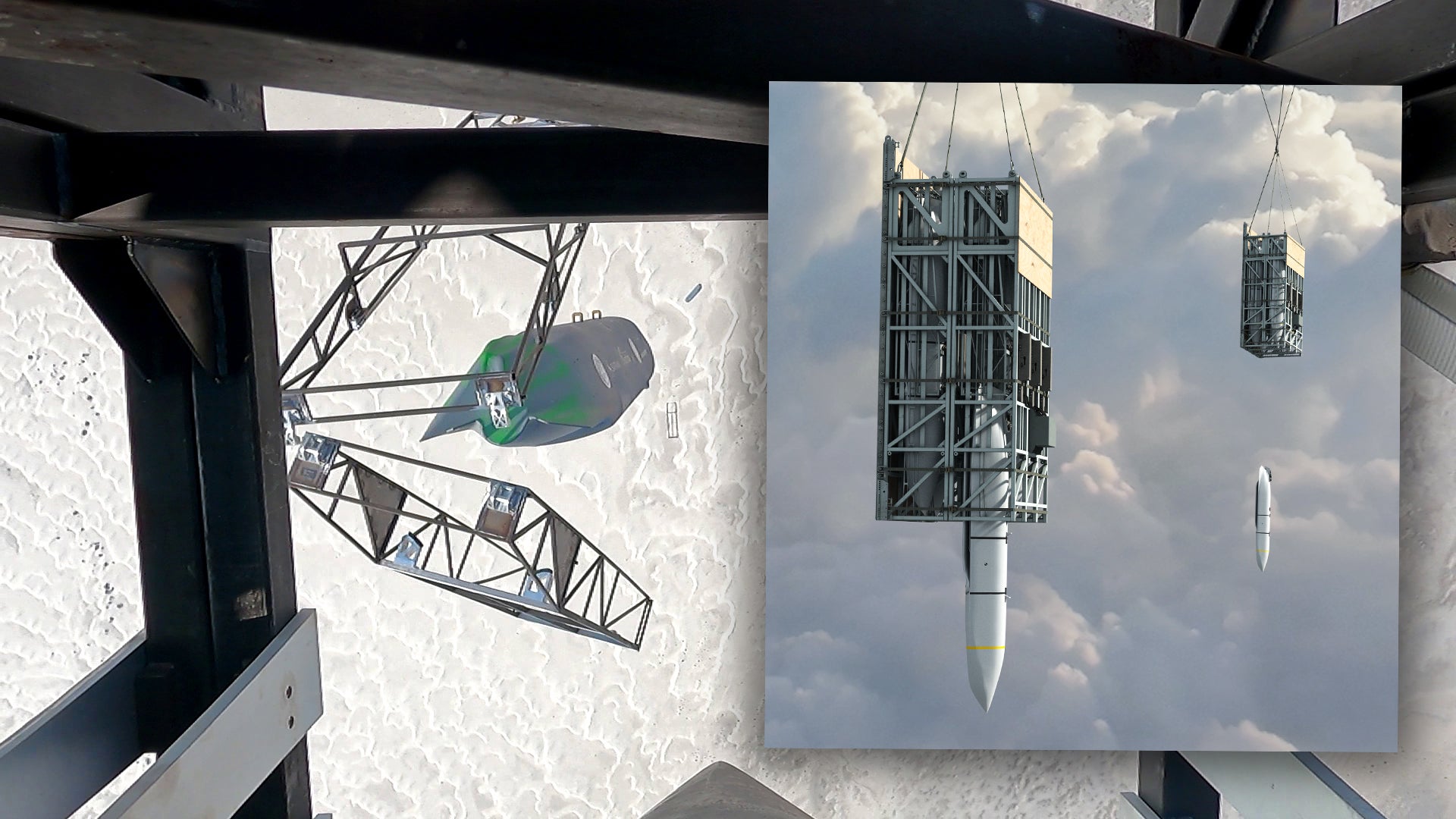
The U.S. Air Force and Lockheed Martin have provided new looks and additional insights into a recent full demonstration of the Rapid Dragon air-launched palletized munitions concept. On this occasion, surrogate weapons were delivered from the cargo holds of a C-17A Globemaster III airlifter and an EC-130J Super J, a psychological warfare platform based on the classic Hercules transport. The development reinforces the swift pace established by this program, which 10 months ago existed only in concept form and is managed by the Air Force’s Strategic Development Planning and Experimentation (SDPE). Its implications could extend beyond the United States as well.
The newly released video and photos show the results of the Rapid Dragon tests that took place over White Sands Missile Range, New Mexico, in August of this year . The various demonstrations, according to Lockheed Martin, “covered all aspects of a palletized strike mission up to and including the release of surrogate cruise missiles,” proving out the basic feasibility of the concept.
Rapid Dragon, which you can read about in detail here , is based around using existing airlifters as ‘weapons trucks.’ This, in turn, is intended to offer a way of boosting the amount of available standoff strike assets, an expedient that might prove beneficial if the United States were to find itself at war with China or Russia, for example.
Outfitting cargo aircraft with a palletized standoff-weapons capability also promises to be far cheaper than fielding additional bombers, making this an even more attractive concept at a time when budgets are stretched. It is also scalable, so smaller or larger airlift assets could potentially employ it. At the same time, America’s finite fleet of airlifters would likely be pushed to its absolute maximum capacity during a peer-state conflict, making the actual viability of such a concept, at least when used in a sustained manner, somewhat debatable. Still, it would be a valuable option to have.

In the August tests involving the airdrops of the Rapid Dragon munition pallet from a C-17 and an EC-130J(SJ), the stores were deployed “at an operationally relevant altitude,” according to Lockheed Martin, although no further details were given about how high the aircraft were flying when they released their payloads.
Once released, and stabilized by parachutes, the munition pallet released surrogate missiles “in quick succession,” these being aerodynamically identical to the AGM-158B Joint Air-to-Surface Standoff Missile-Extended Range cruise missile, or JASSM-ER , which has a publicly stated range of at least 575 miles.
“These Rapid Dragon deployments represent the first end-to-end demonstration of a palletized strike mission, from rolling missile pallets onto an aircraft to in-flight missile release,” said Scott Callaway, Lockheed Martin Advanced Strike Programs director, of the tests at White Sands. “They are a big step toward showing the feasibility of the palletized munitions concept and the ability of mobility aircraft to augment the strike capacity of tactical fighters and strategic bombers.”
Lockheed Martin also provided further details about the targeting process used in the tests. In both the C-17 and EC-130 flights, personnel on the ground used beyond-line-of-sight communications (satellite communication datalinks) to transmit targeting data to the Rapid Dragon system, demonstrating the ability to retarget the missiles while the launch aircraft is airborne.

From what the Air Force and Lockheed Martin have shown now of the Rapid Dragon system, we also clearly see that it is intended to be a modular, scalable concept, at least with regard to the JASSM-ER. The missiles are each loaded into their own individual “deployment box,” which has an open, metal-framed design and breaks in half to release the missile. They can be arrayed in rows or stacked one on top of each other on a pallet. In real-world testing, so far, we have seen four missiles loaded on a single pallet in a 2-by-2 array, but concept art and models have shown six and nine-missile loads, as well.

More tests are planned for the months to come and, while the August trials have been billed as an end-to-end test, the missiles deployed were surrogates. Before the end of this year, the next milestone should see an MC‑130J special operations transport drop a real, powered example of the JASSM-ER, to fully demonstrate the capabilities of this intriguing concept.
While not being addressed officially at this time, there also is a potential export possibility that could be an even bigger game-changer for U.S. allies and partners. While none of them have bombers, they do have transport aircraft. With this concept being adaptable enough to even fit in a derivative of the M28 Skytruck , it could give these countries a powerful standoff strike platform option that would augment any limited fighter aircraft capacity they may have.

In addition, the range an airlifter provides greatly increases the reach for such operations over fighter aircraft, unless aerial refueling is available, and even then their carriage capabilities are limited. Also, during major hostilities, any fighters in their inventories will be heavily tasked. As such, this capability makes a C-27J, C-130, or a C-17 a cruise missile carrier with minimal cost or modifications.
Of course, the missiles still have to be purchased, but the JASSM is already in service with Poland, Finland, and Australia, all of which could see great value in the Rapid Dragon concept in the current geopolitical and strategic climate. More countries are likely to be added to the JASSM user list as well. It’s possible Rapid Dragon could be adapted for other missiles, as well, including those less advanced and tightly controlled than JASSM. One could imagine there would be a massive market for such a capability.
There is also the possibility this could be used to launch small drones that can be recovered via parachute or conventional landing after their missions. Launching swarms in this fashion could be hugely beneficial, with a cruise missile-like modular drone that can be rapidly reconfigured to host warheads, sensors, communications, and other payloads.
Regardless, after lots of talk about turning airlifters into arsenal ships and weapons trucks, it looks like a way to do just that with minimal modifications has arrived, and rapidly so, as the name suggests.
Contact the authors: [email protected] and [email protected]

IMAGES
VIDEO